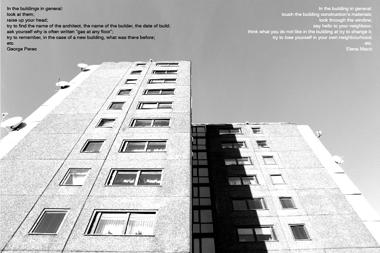- Botkyrka konsthall
- Botkyrka kommun
- 147 85 TUMBA
- +46 8 530 612 25
- SWEDISH
ARTISTS
Elena Mazzi
Venice
November 2010 - January 2011
My staying at Residence Botkyrka gave me the possibility to be in touch with the environment I was looking for. My work on Modernist Style’s satellite cities around Europe has assumed a real form after living in Fittja for two months. Here, the concept of Functionalism has been pushed at extreme levels during Sixities and Seventies. The day-by-day routine helped me to understand better a society that does not exist anymore, but that was part of our history. We everyday face with the past, and the traditions that we take with us, all over the world.
The warm and inviting atmosphere found at Multicultural Centre close to the apartment helped me to concentrate and confront with different researchers. I think this kind of evironment gives artists the opportunity to develop projects based on private/public space and multiculturalism. But what does it mean multiculturalism if not sharing knowledge with people?
The process started in Botrkyrka will continue in Centrifug space at Konsthall C, from the 9th to the 27th of March with Preview Platform, and will end in May with a performance that will take place through the suburbs, with the collaboration of Per Wirtén, Andrzej Markiewicz and Botkyrka Konsthall.
Elena Mazzi, January 2011
The goal of my research is to analyse different ways to live the space that surrounds us, specifically space to live in. How can space influences our daily living and our actions? How can space that surround us helps an individual to better live? What are the characteristics of houses in our time? What are the criterion taken into consideration, and who decide them?
I am an italian artist and I am here in Stockholm, precisely in Fittja, to understand the Million homes programme realized during ’60 and ’70 in suburbs around Stockholm because of the lack and consequently demand of houses. The ambition to create an exemplar welfare State through a tidy and strong image of new districts, giving a feeling of social equality under the name of Functionalist Movement, did not work. Swedish people left suburbs, that have as new occupants immigrant people, in many cases closed in a situation of segregation. But still, the Million Home programme has seen from the rest of Europe as a model to follow. In Italy, Berlusconi is changing the image of Italian cities, creating New Towns. In particular, I am taking into consideration the city of L’Aquila, destroyed by the earthquake in April 2009.
What I am trying to figure out is how the citizen can deal with the architecture where he lives and in what way is influenced by it. Does the idea of functionalism allow us to renew a city, or rather it destroyes the memory of the city? What are the existing alternatives and what other alternatives can be created by the inhabitants themselves? And if we really need an architecture well structured around us to better live, why people are escaping from it?
Elena Mazzi, December 2010
http://en.wikipedia.org/wiki/Million_Programme http://en.wikipedia.org/wiki/Functionalism_%28architecture%29 http://en.wikipedia.org/wiki/L%27Aquilahttp://www.abitare.it/featured/laquila-progetto-case/ |
ARCHIVE
Marta Bogdanska Dominik Kurylek Ivars Gravlejs Jaana Kokko Lena Séraphin Sasha Huber and Petri Saarikko Laercio Redondo and Birger Lipinski Tarek Zaki Phil Hession Dzamil Kamanger, Kalle Hamm, Minna Henriksson and Sezgin Boynik Heidi Lunabba JP Kaljonen |
Residence Botkyrka is run by Botkyrka konsthall, with support from The Foundation for the Culture of the Future, in collaboration with the City Planning Department in the municipality of Botkyrka, the Multicultural Centre and the housing corporation Botkyrkabyggen.
